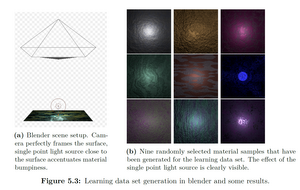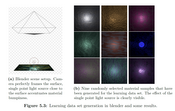Information
- Publication Type: Bachelor Thesis
- Workgroup(s)/Project(s): not specified
- Date: March 2025
- Date (Start): 1. September 2024
- Date (End): 1. March 2025
- Matrikelnummer: 01429490
- First Supervisor: Martin Ilčík
Abstract
I explore the possibility of generating procedural Blender shaders of self-similar semiregular surfaces from an input image derived from photograph or digital render. The resulting Blender shader should produce a Material with a look similar to the input image. This would be useful because procedural materials give 3D artists flexibility and creative control over the materials look, that image based materials cannot, while inheriting all the benefits of said image based materials, like availability and ease of use. This shader generation is done by a neural parameter predictor and subsequent extraction of a sub-shader from a given, pre-built, general shader graph (the super-shader). The parameters are predicted by a MLP neural network using statistical texture descriptors as its input. Those descriptors are extracted from a pre-trained image classification CNN, which uses the original photograph/render as its input. Using this pipeline a large learning dataset for the MLP can be easily artificially generated with Blender by rendering the super-shader with randomized parameters.Additional Files and Images
Weblinks
No further information available.BibTeX
@bachelorsthesis{winklmueller-2025-ims,
title = "Inverse Material Synthesis via Sub-Shader Extraction",
author = "Marcel Winklm\"{u}ller",
year = "2025",
abstract = "I explore the possibility of generating procedural Blender
shaders of self-similar semiregular surfaces from an input
image derived from photograph or digital render. The
resulting Blender shader should produce a Material with a
look similar to the input image. This would be useful
because procedural materials give 3D artists flexibility and
creative control over the materials look, that image based
materials cannot, while inheriting all the benefits of said
image based materials, like availability and ease of use.
This shader generation is done by a neural parameter
predictor and subsequent extraction of a sub-shader from a
given, pre-built, general shader graph (the super-shader).
The parameters are predicted by a MLP neural network using
statistical texture descriptors as its input. Those
descriptors are extracted from a pre-trained image
classification CNN, which uses the original
photograph/render as its input. Using this pipeline a large
learning dataset for the MLP can be easily artificially
generated with Blender by rendering the super-shader with
randomized parameters.",
month = mar,
address = "Favoritenstrasse 9-11/E193-02, A-1040 Vienna, Austria",
school = "Research Unit of Computer Graphics, Institute of Visual
Computing and Human-Centered Technology, Faculty of
Informatics, TU Wien ",
URL = "https://www.cg.tuwien.ac.at/research/publications/2025/winklmueller-2025-ims/",
}



